Back to page 1
The Design
Not only does the “sturdy storm shelter” look continue on the inside of Werner Park, there are some design elements that I really love.
 |
One is the concourse. When you first walk in through the main gates, there is a large plaza where you can meet your friends (below left). To your right is the souvenir store, and next to it are concession stands. Right in front of you is a great view of the field as you look under the upper level.
When a new ballpark fails to have a 360-degree concourse, I think it’s a mistake. Never fear, because Werner Park’s concourse circles the entire field, giving you a very pleasant third-of-a-mile walk. On the outfield side, you can look beyond the park at the meadows, and as you look in toward the action, you’ll notice my very favorite design element of the ballpark.
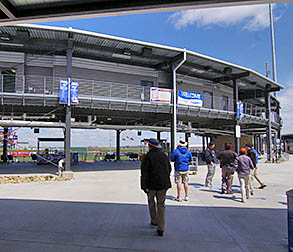 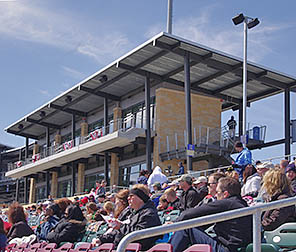 |
That outstanding element is actually “elements.” At the rear of the seating bowl behind both dugouts are two two-story structures housing 14 luxury suites (above right is the one on the third-base side), all named for former players or managers. Almost always, suites in Minor League parks are on the upper level, extending far down both foul lines. Not here. By stacking them, the suites are closer to the batter, thereby negating the most common complaint about suites: they are too detached from the action. Here, you really feel like you’re part of the game even if you are with a group in one of the suites.
This provides the added advantage of making the entire park much more intimate … and therein lies the key difference between Werner Park and its predecessor, Rosenblatt Stadium.
Say what you want about The ‘Blatt’s sense of history, you could never describe it as intimate. It was expanded and expanded to accommodate the ever-growing crowds that were clamoring for College World Series tickets every June. At Werner Park, though, you feel like you’re part of an intimate gathering, even when there’s 6,000 or 8,000 fans in the place.
So you could probably think of Werner Park as the “Anti-Rosenblatt.” Not only is it more intimate (while still offering more legroom and wider seats), it also differs from The ‘Blatt in another hugely important way, especially if you’re the front office of the Storm Chasers.
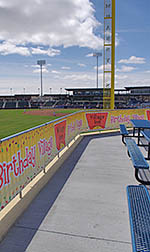 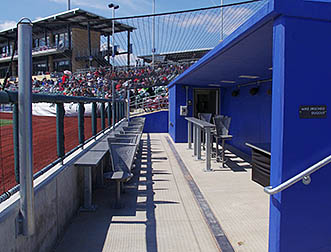 |
That essential difference is the ability to accommodate groups. “This is a market where a lot of fans like to come to games as part of a group,” Cordaro explained. “Our ability to accommodate groups was very limited at Rosenblatt.” Obviously rectifying this was a key objective in designing Werner Park. I counted no fewer than seven such areas in the new park: on the upper level on each side of the press area are party decks; the picnic area way behind first base (that you could see inside the wire fence on the first page of this review); in a large tent beyond the right-field foul pole; in another tent on the left field side; the Village Inn Birthday Village at the base of the left-field foul pole (above left) …. and one more, that is indeed unique.
That wonderfully unusual group area is the Mike Jirschele Dugout Suite (above right). It is exactly like the area where the players sit, except 1. It is farther down the third-base foul line; 2. It is completely wrapped in netting so a screaming line drive doesn’t ruin someone’s evening; 3. It has its own bathroom; 4. You have a counter top on which you can set your food and drink. Jirschele, by the way, is the current Storm Chasers manager. He’s been the skipper of the team for the past 11 seasons.
And in counting seven areas for groups, I didn’t even include the Club Bar (below) which is on the ground level of the suites structure on the first-base side. Here you can bring in food from another concession stand and combine it with the beverage of your choice. There are even garage-door-like devices that are open when it’s pleasant outside or closed when it’s not — and it was frightfully cold the day I was there, so those doors were closed.
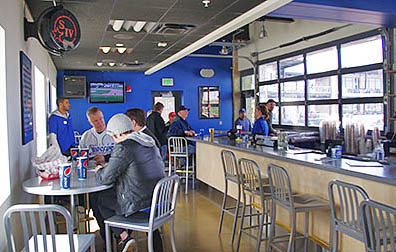 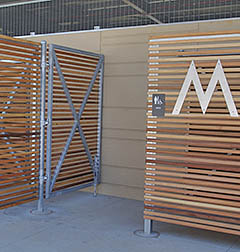 |
And the storm shelter look is continued in clever ways around the park’s interior, such as at the entrance to the men’s room (above right). And if you look closely here, you’ll see that the walls around the rest rooms don’t go all the way up to the ceiling. That’s one of the many, many ways the park’s construction is considered to be “sustainable.” Examples include utilizing building materials that didn’t have to be trucked over long distances, and instead of electric ventilation for the rest rooms, the areas near the ceilings are open. I’ll be curious to hear how well that is working out when the weather gets really hot and the breezes aren’t blowing as much as in the early spring.
Finally, the outfield walls need to be addressed. First, the two bullpens are “stacked” — which isn’t so unusual these days, but putting them in dead center field is unusual. Second, the right-field wall is quite “wavy” as it makes its way from the foul pole to center field (below). “Beyond right field is a draw, and just on the other side of that is a stream,” said Garlock, the park’s lead designer. “We wanted the park snuggled up against that small hill, and we wanted the right-field wall to meander, much like the stream beyond it does.”
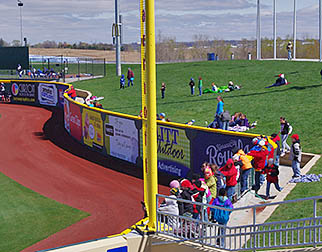 |
The Essentials
So the design of Werner Park has some different elements than most other new parks, and that’s a good thing. Plus it works extremely well in a market where there is heavy demand by groups. But what is the game-day experience like?
Let’s tackle the question of “cost” first. I never like to pay for parking at Minor League facilities, but at Werner Park they give you a choice …. and I can’t think of another facility where this is the case. If you don’t mind spending $2, you can park your car fairly near the main entryway ($5 buys you a spot right by the entry). If you don’t want to spring for the $2, you’ll have to park a little farther away — but still within the park’s acreage. I love giving fans the choice.
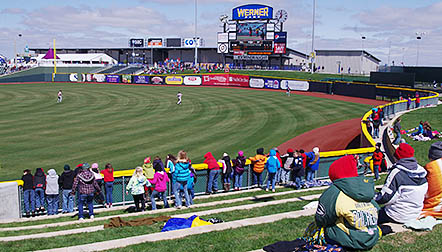 |
Ticket prices are really reasonable for a new park, especially one at the Triple-A level. Seats on Fridays and Saturdays cost $16.50 in the Club area, $12.50 for Field Boxes, regular Boxes are $10.00 and the AT&T Homerun Porch in left field costs $6.50. The Club, Field and Box seats all cost $1.00 less the rest of the week. And while I’m not crazy about the aesthetics of doing this, the color of your seat tells you which price category you’re in: blue is for Club seats; the Field Boxes are dark red and the regular Boxes are green.
Sitting on the berms is actually cheaper ($6, regardless of the day of the week) than the cheapest O-Royals ticket at The ‘Blatt — plus the first 50 kids brought to the ticket window at each game will get in for only $1. By the way, for most Storm Chasers games, you won’t need parkas and blankets like the fans at the mid-April game above.
And if you’re curious about the dugout suite, it costs $575 before you add in food. It can accommodate up to 18 people. And it really is a memorable vantage point.
If you’re looking for souvenirs, team Merchandise Manager Jason Kinney will gladly show you around the Storm Front store (below left). “Our new store is four times the size of the one at Rosenblatt,” he said proudly. “We can offer a much bigger selection now.” Like the ticket prices, the cost of the merchandise is easy on the wallet. Adult t-shirts range from $19.99 to $29.99, with a lot of them coming in at the low end of that range. Fitted and adjustable caps are both $23.99, and kids’ t-shirts cost from $14.99 to $19.99.
 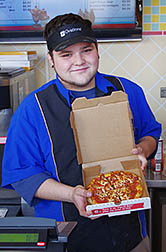 |
I’m delighted to be able to say that Ovations, the same company that does such an outstanding job handling the food at new Salt River Fields in Arizona, also does the food here in Nebraska. And like at Salt River, Ovations carefully selects local eateries to provide the concessions at Werner Park.
All of the food I sampled was excellent, but as I asked around to find out what stand people liked best, one name came up over and over: Extreme Pizza (above right, with stand manager Tony showing off a pepperoni pie). Located all the way down in the left-field corner, this stand is worth the walk from any corner of the ballpark. Their slogan is “Extreme, not mainstream,” and that is the perfect description, because their pizza is nothing like typical ballpark fare. Their creations have much more flavor (I assume due to the spices they utilize) than any pizza I’ve eaten at a ballpark, and are a bargain at $6.00 for a plain, personal-size pizza, $6.50 with one topping, and $7.50 for one of their special combinations of toppings.
Other highly regarded food items include an Omaha Dog for $5.00 at the Dog Nation stand behind home plate, Omaha Steaks’ 1/2-pound cheeseburgers at the Grand Slam Grill (behind first base) for $6.00, either two tacos or a burrito for $6.00 next door at La Mesa, a Popcorn Chicken Cup for $5.00 at Chicken Fry Fry and a BBQ Pork Sandwich with chips from Famous Dave’s (below left) for $7.00. For those of you who’ve attended the College World Series at Rosenblatt, you’ll know Famous Dave’s for its long lines and indescribably delicious BBQ directly across the street from the main gates. Glad to see them at Werner Park!
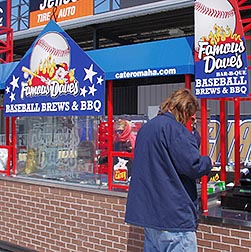  |
In case you’re keeping score at home, the Storm Chasers play in a Pepsi park, not a Coke park. And 16-ounce domestic drafts are $5.00 and imports are $6.00.
While I think the double-deck luxury suites are Werner Park’s signature feature, GM Cordaro disagrees. “If we have a signature feature, it has to be our kids’ area. Parents can easily keep an eye on the game while their kids play right nearby.” You know, he might have a point, because the Centris Family Fun Zone (above right) might be the nicest play area I’ve ever seen at a Minor League park. Where else are you going to find a merry-go-round that was purchased from Universal Theme Park in Orlando, a pitching machine, various inflatable attractions and a jungle gym? For $5, kids can ride the carousel and play the games as much as they want.
And if that weren’t enough, there is a basketball court (below left) and a wiffle-ball field nearby in center field. Honestly, as a family entertainment destination, this might be the most complete ballpark (below the Majors) there is.
 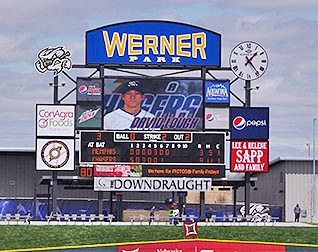 |
They didn’t scrimp on the scoreboard (above right), either. Not only does it look great in direct sunlight (and not all video screens do), it has a clock, pitch speed, message board, 31-foot-wide high-res video, lots of ad signs, a bar underneath it … and a banner the size of an 18-wheeler on the top with the name of the company that bought the naming rights of the stadium. And it’s appropriate that the sign is as big as a big rig because Werner Enterprises is a global transportation company headquartered just a few miles away, right there in Sarpy County.
Truly, when you add all of its elements together, this is a complete park, one that opened on time and opened in a nicely finished state.
But that doesn’t mean that there’s no room for expansion. To the contrary, Werner Park was designed with the ability to add new features in the future. “We are always looking forward and an enclosed banquet facility would be on the top of our list,” Cordaro said. After all, you can never have too much space for groups to congregate!
Summary
The gloriously sunny — but cold — day when I attended a game at Werner Park was still in the stadium’s first week. Have locals had the chance to form an opinion?
“The first three games I attended here represent the best three days of my baseball life,” said Jerry Strawn, a resident of Papillion, which is technically the Sarpy County town in which the ballpark is located. Jerry is a first-year season-ticket holder who told me that Werner Park is “so much nicer than Rosenblatt because it’s smaller here. Here you’re 18 rows from the grass (when you’re on the concourse). This is really the way to go. It’s more kid-friendly (than Rosenblatt) and really it’s easier to get here from anywhere in the area.”
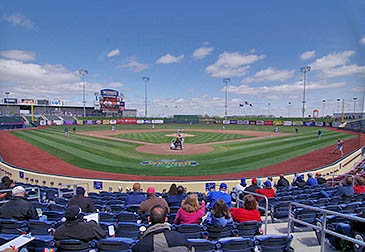 |
When I asked Storm Chasers’ GM Martie Cordaro if he’s happy that his team is in Sarpy County instead of playing in downtown Omaha, there was no hesitation in his response. “Oh, yes. We would’ve been in Rosenblatt on steroids downtown (at TD Ameritrade Park). After all the things we’ve been about — families, fun and affordability — it would’ve been disingenuous for us to be there. And we can now show people what Minor League Baseball is about.”
He added that the architects at DLR designed “us a real ballpark. Rosenblatt was what it was, but now we are all about baseball. We didn’t have a place before where we could show it. Now we have a physical plant where we can do it right.”
Indeed, there is a lot that can be done with a facility as nice as Werner Park. And after all of the storms of uncertainty about where the franchise would end up, the team now known as the Storm Chasers has a sturdy, permanent shelter in which to hunker down for the long haul.